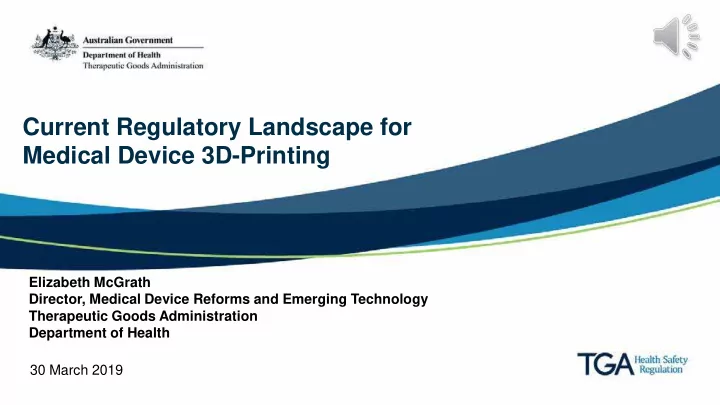

Current Regulatory Landscape for Medical Device 3D-Printing Elizabeth McGrath Director, Medical Device Reforms and Emerging Technology Therapeutic Goods Administration Department of Health 30 March 2019
Medical device 3D printing - This talk – Scope – Overview of medical device regulation — including mass produced 3D-printed devices – Current regulation of 3D-printed medical devices made for a particular patient – Consultation for regulatory reforms – International harmonisation – Next steps 2
Medical Device 3D-Printing - Scope Ⅲ Test beds for Medicine Preclinical Testing and Research Ⅲ Medicines Ⅲ Anatomical Models for Teaching � Anatomical Models for Investigation of a Patient’s Anatomy � Externally Applied Medical Devices � Invasive Medical Devices � Implantable Medical Devices 3
Medical device regulatory framework in Australia (including mass-produced 3D-printed devices) 4
Regulatory requirements for medical devices • Does it Fit the Definition of a Medical Device? • Apply the Classification Rules • Evidence of Safety, Performance and Quality • Regulatory Review of Evidence (if device is above Class I) • Manufacturing Certification (if device is above Class I) • Inclusion in the ARTG • Post-Market Requirements – Monitor Post-Market Performance – Report Problems to the TGA – Annual Manufacturing Inspections 5
What is a medical device? Defined in s41BD of the Therapeutic Goods Act 1989 Bandages Any instrument, apparatus, appliance, material or other article intended to be used for human beings for the purpose of one or more of the following (i) diagnosis, prevention, monitoring, treatment or alleviation of Dental implant disease; (ii) diagnosis, monitoring, treatment, alleviation of or compensation for an injury or disability (iii) investigation, replacement or modification of the anatomy or of a Breast implant physiological process (iv) control of conception; and that does not achieve its principal intended action in or on the Glucose monitor human body by pharmacological, immunological or metabolic means, but that may be assisted in its function by such means 6
Regulatory oversight increases with risk category Regulatory Scrutiny ✔✔✔✔ • Class III High Risk ✔✔✔ • Class IIb ✔✔ • Class IIa Low Risk ✔ • Class I 7
Some Exceptions Special Access Scheme for Unapproved Goods Experimental Product Exemptions Custom-M ade M edical Devices In-House In Vitro Diagnostic Devices 8
Medical device regulatory framework in Australia (3D-printed devices - excluding mass-produced) 9
Custom-made medical device • the Regulations define a custom-made medical device as … 10
Custom-made medical devices Exempt from Inclusion in the Australian Register of Therapeutic Goods Sponsors and/or M anufacturers must notify the TGA that they are supplying devices in Australia No third-party oversight of manufacturing or device EP compliance evidence 11
Are consumers protected under these requirements? • Custom-made implants are not currently subject to third-party pre-market review of safety, quality and performance • Historically, custom-made medical devices were considered to comprise low-risk products, or be very limited in number • High-risk devices , e.g., implants, that are manufactured conventionally are subject to rigorous regulatory oversight of design and manufacture • There are some novice players with limited awareness of QMS and regulatory requirements involved in 3D-printed device development 12
Regulatory reform ahead 13
Public consultation • Same proposals previously consulted at the end of 2017 • Includes further detail to clarify proposals • Seeks to understand impact on stakeholders https:// www.tga.gov.au/consultations-reviews 14
Current consultation proposals Proposal 1 — Introduce new definitions • Personalised medical device • Patient-matched medical device • Adaptable medical device Proposal 2 — Change the requirements for supplying custom-made medical devices • Annual reporting to the TGA • Provide information about the device to patients • Allow the TGA to inspect manufacturing sites Proposal 3 — Introduce a ‘medical device production system’ • Allow healthcare providers to produce lower-risk personalised devices for treating their patients, without the need for manufacturing certification 15
Current consultation proposals Proposal 4 — Update the classification rule for medical devices that record diagnostic images • Includes any device for this purpose and not just X-rays, for example, 3D-printed models of patient anatomy Proposal 5 — Regulate medical devices with a human-origin component, for example, a 3D-printed implant incorporating cells from the patient, as medical devices with a biological component rather than as pure biologicals Proposal 6 — Clarify that any modifications or adaptations, to personalise a medical device that has already been supplied, must have been intended by the original manufacturer of the device. 16
International harmonisation 17
International Medical Device Regulators Forum (IMDRF) • Global harmonisation initiative established in 2011 • Current members are: – Japan,* – Australia* – Russia, – Brazil,* – Singapore, – Canada,* – South Korea, – China, – the United States* – the European Union, * Founding members Personalised M edical Devices Working Group • Established 2017 • Australia is Chair 18
IMDRF documents from the PMD working group 19
Next steps in Australia Use of 3D-printing for patient specific applications is increasing, but does our existing regulatory framework adequately mitigate risk for patients? What’s next… • Analyse results of current consultation • Seek government approval for regulatory changes based on consultation proposals and responses • Implement changes following an appropriate transition period 20
Further information TGA website • Medical devices (https://www.tga.gov.au/medical-devices-ivds) • SME Assist (https://www.tga.gov.au/sme-assist) • News, consultations, guidance, subscribe to updates IMDRF website • International Medical Device Regulators’ Forum (http://imdrf.org) Contact the TGA Medical Devices Branch • devices@tga.gov.au ph.: 1800 141 144 21
Recommend
More recommend